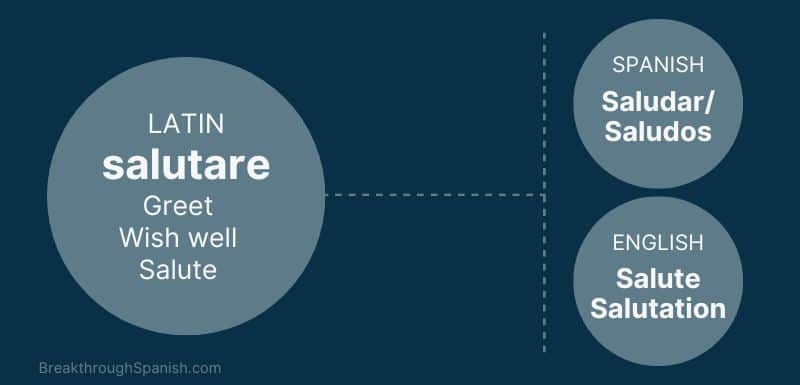You’ve probably heard it by now: Spanish speakers use “saludos” all the time.
But its usage can be tricky. So in this article, you’re going to learn the meaning, clear examples for how to use it, and pronunciation mistakes to avoid. (Prefer video? Check out my short explanation below).
¡Vamos!
What does saludos mean in Spanish?
Saying saludos is most similar to ‘kind regards’ or ‘cheers’ in English. It’s common, especially in written Spanish, because it’s neither too formal nor too informal.
When you say it, you’re actually wishing good health to a person. That’s because saludos comes from la salud— health.
And if we look back to Latin, we get an even clearer picture.
The Spanish saludos comes from the Latin salutare, meaning to greet, salute, visit, or wish well.
Salutare is the same root as the English word salutations or salute.
But saying saludos is a lot more normal and less weird than saluting or saying salutations to a friend.

How do you pronounce saludos?
A TIP:
Common words like saludos (and especially the expressions they come in) are a great way to practice pronunciation. Rather than practicing sounds in isolation, you’re using them into short, natural sequences.
Listen to examples of the expressions below and record yourself so you can compare the differences in pronunciation.
If you enjoy that kind of exercise, I think you’d get a lot out of my pronunciation course — Confident Spanish Pronunciation. Click here to check it out.
The word saludos contains two troublesome letters for North American English speakers: D and L.
In our English, we trill our D’s when between two words, like idol or adamant.
This is the ‘r’ sound in Spanish words like pero or cara— not the sound used for D’s.
The Spanish D is soft. It’s most similar to the English “th” sound in in “this”, but even softer. In many dialects, it’s swallowed, such that it sounds more like “salu’os”.
The L is also different. In English, we usually put our tongue flat against the roof of our mouth to pronounce the L. Say play or later and you’ll see what I mean.
When you say the L in Spanish, the tip of your tongue should hit the roof of your mouth.
Listen to a native speaker pronounce it here.
A reliable exercise to improve your Spanish pronunciation: record yourself on your phone and compare your pronunciation to theirs, focusing on the D and L.

Saludos examples: How to use it in spoken Spanish
The first common scenario you’ll hear is when people use saludos to say, “Say hi to so and so for me”.
For example:
- (Muchos) Saludos a tu familia
- Literally: (Many) Greetings to your family.
- Colloquially: Say hey to your family for me
- Use: As a quick parting line
- Mándale saludos a tu familia de mi parte.
- Literally, “Send to them greetings to your family on my part.”
- Colloquially: “Say hi to your family for me” or “send my regards to your family”.
- Use: When you run into someone you know
- Sólo quería mandarte un saludo
- Literally: I just wanted to send you a greeting.
- Colloquially: I just wanted to say hey
- Use: the end of a conversation
- Mis padres te mandan saludos
- Literally: my parents to you send greetings
- Colloquially: My parents say hey
- Use: To convey someone else’s greeting
Using saludar as a verb
Remember, the Latin salutare was a verb meaning to greet or wish well.
Over many generations, salutare became saludar, a Spanish verb with similar meaning.
Here’s how to conjugate saludar:
| yo | saludo |
| tú | saludas |
| él, ella, usted | saluda |
| nosotros | saludamos |
| vosotros | saludáis |
| ellos, ellas, ustedes | saludan |
Examples:
- Quería saludarte pero nunca te vi!
- I wanted to say hi but I never saw you!
- Así no es como saludas al presidente
- That’s not how you greet the president
- “¿Dónde están tus modales, que no aprendiste ni a saludar?
- Where are your manners, you can’t even say hello?
- Salúdame a tu hermano.
- Literally: Greet me to your brother
- Colloquially: Say hi to your brother for me / Send my regards to your brother
How do you respond to saludos?
When someone says saludos a tu familia, the best response isn’t “will do”, but rather “gracias”.
In Spanish, it’s polite to thank someone for being considerate in that way.
Other good replies include:
| Igualmente | Likewise |
| Saludos a todos por allá también | Greetings to everyone there too |
| Gracias, serán dados | Thanks, they will be given (will do). |
| ¡Con gusto! | Gladly! |
Saludos examples: How to use it in written Spanish
One of the most common places you’ll see this word is in emails and other written messages.
For example:
| Saludos | Cheers, kind regards. A great one word email sign-off. |
| Saludos desde la distancia | Greetings from afar |
| Saludos desde Madrid | Greetings from Madrid |
| Saludos cordiales | Best regards, kind regards (a bit more formal) |


Done learning? Time to practice
Hopefully now you understand saludos and feel confident using it.
Practice it now: imagine you run into someone want to send your saludos to someone:
“Say hi to so-and-so for me”.
Make it a real person you know, and practice saying it. That way, the first time you go to say it to a real person won’t be the first time you’ve ever tried to say it.



Can Saludos be used to after have someone after someone sneezes?
Yes! ¡Salud! is used like “bless you” is in English